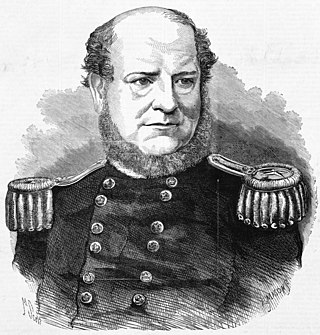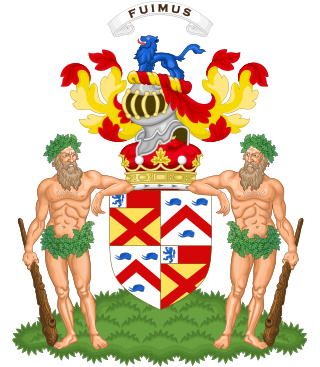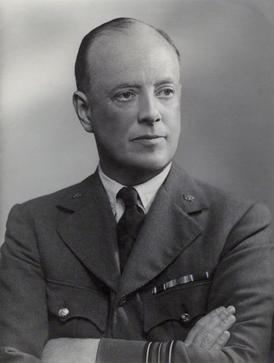
George Augustus Constantine Phipps, 2nd Marquess of Normanby, styled Viscount Normanby between 1831 and 1838 and Earl of Mulgrave between 1838 and 1863, was a British Liberal politician and colonial governor of Nova Scotia, Queensland, New Zealand and Victoria.

Viscount Cobham is a title in the Peerage of Great Britain that was created in 1718. Owing to its special remainder, the title has passed through several families. Since 1889, it has been held by members of the Lyttelton family.

Marquess Townshend is a title in the Peerage of Great Britain held by the Townshend family of Raynham Hall in Norfolk. The title was created in 1787 for George Townshend, 4th Viscount Townshend.

Marquess of Headfort is a title in the Peerage of Ireland. It was created in 1800 for Thomas Taylour, 2nd Earl of Bective.

Marquess of Exeter is a title that has been created twice, once in the peerage of England and once in the peerage of the United Kingdom. The first creation came in the peerage of England in 1525 for Henry Courtenay, 2nd Earl of Devon. For more information on this creation, which was forfeited in 1538, see Earl of Devon.

Marquess of Cholmondeley is a title in the Peerage of the United Kingdom. It was created in 1815 for George Cholmondeley, 4th Earl of Cholmondeley.

Marquess of Londonderry, of the County of Londonderry, is a title in the Peerage of Ireland.

Marquess of Ailesbury, in the County of Buckingham, is a title in the Peerage of the United Kingdom. It was created on 17 July 1821 for Charles Brudenell-Bruce, 2nd Earl of Ailesbury.

Marquess of Abergavenny in the County of Monmouth, is a title in the Peerage of the United Kingdom created on 14 January 1876, along with the title Earl of Lewes, in the County of Sussex, for the 5th Earl of Abergavenny, a member of the Nevill family.

Marquess of Reading is a title in the Peerage of the United Kingdom. It was created in 1926 for Rufus Isaacs, who had been Member of Parliament for Reading between 1904 and 1913, before serving as Viceroy of India and Lord Chief Justice of England and Wales. He had already been created Baron Reading, of Erleigh in the County of Berkshire, in 1914, Viscount Reading, of Erleigh in the County of Berkshire, in 1916, and Viscount Erleigh, of Erleigh in the County of Berkshire, and Earl of Reading, in 1917.

Earl of Cardigan is a title in the Peerage of England, currently held by the Marquesses of Ailesbury, and used as a courtesy title by the heir apparent to that Marquessate, currently David Brudenell-Bruce, Earl of Cardigan, son of the 8th Marquess. The Brudenell family descends from Sir Robert Brudenell, Chief Justice of the Common Pleas from 1520 to 1530. His great-grandson, Sir Thomas Brudenell, was created a Baronet in the Baronetage of England, styled "of Deene in the County of Northampton", on 29 June 1611. On 26 February 1628, he was raised to the Peerage of England as Baron Brudenell, of Stanton Wyvill in the County of Leicester, and on 20 April 1661 he was further honoured when he was made Earl of Cardigan, also in the Peerage of England. On his death, the titles passed to his son, Robert, the 2nd Earl, and on the 2nd Earl's death to his grandson, George, the 3rd Earl, the 2nd Earl's only son, Francis, Lord Brudenell, having predeceased his father.

The Mountbatten family is a British dynasty that originated as a British branch of the German princely Battenberg family. The name was adopted on 14 July 1917, three days before the British royal family changed its name from "Saxe-Coburg and Gotha" to "Windsor", by members of the Battenberg family residing in the United Kingdom, due to rising anti-German sentiment among the British public during World War I. The name is a direct Anglicisation of the German Battenberg, or Batten mountain, the name of a small town in Hesse. The titles of count and later prince of Battenberg had been granted in the mid-19th century to a morganatic branch of the House of Hesse-Darmstadt, itself a cadet branch of the House of Hesse.

Earl or Lord of Clanricarde is a title that has been created twice in the Peerage of Ireland, first in 1543 and again in 1800. The former creation became extinct in 1916 while the 1800 creation is extant and held by the Marquess of Sligo since 1916.

Baron Dufferin and Claneboye, of Ballyleidy and Killyleagh in County Down, Northern Ireland, is a title in the Peerage of Ireland. It was created on 30 July 1800 for Dame Dorcas Blackwood, widow of Sir John Blackwood, 2nd Baronet, Member of the Irish Parliament for Killyleagh and Bangor, in return for support for the Union of Ireland and the United Kingdom.

William Nevill, 1st Marquess of Abergavenny, styled Viscount Neville between 1845 and 1868 and known as The Earl of Abergavenny between 1868 and 1876, was a British peer.

Marie Adelaide Freeman-Thomas, Marchioness of Willingdon, was a daughter of Thomas Brassey, 1st Earl Brassey. On 20 July 1892, she married Freeman Freeman-Thomas, 1st Marquess of Willingdon, the future Governor General of Canada and Viceroy of India. They had two sons, Lieutenant Gerard Frederick Freeman-Thomas, killed, aged 21, in the First World War, and Inigo Brassey Freeman-Thomas, 2nd Marquess of Willingdon.

Freeman Freeman-Thomas, 1st Marquess of Willingdon,, styled as the Earl of Willingdon between 1931 and 1936, was a British Liberal politician and administrator who served as Governor General of Canada and as Viceroy and Governor-General of India.

Marquess is a rank of nobility in the peerages of the United Kingdom.
Freeman Frederick Thomas was an English cricketer active from 1860 to 1867 who played for Sussex. He was born in Lymington, Hampshire, and died in Sanremo, Italy. He appeared in nine first-class matches as a right-handed batsman who scored 89 runs with a highest score of 15.

Inigo Brassey Freeman-Thomas, 2nd Marquess of Willingdon, was a British Liberal Party politician and the second son of Freeman Freeman-Thomas, 1st Marquess of Willingdon, a former Viceroy of India. From 1931 to 1941 he was styled Viscount Ratendone.












